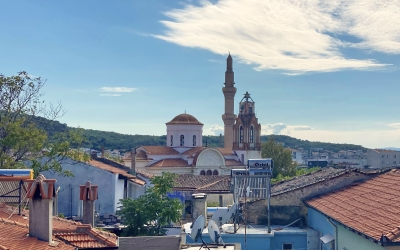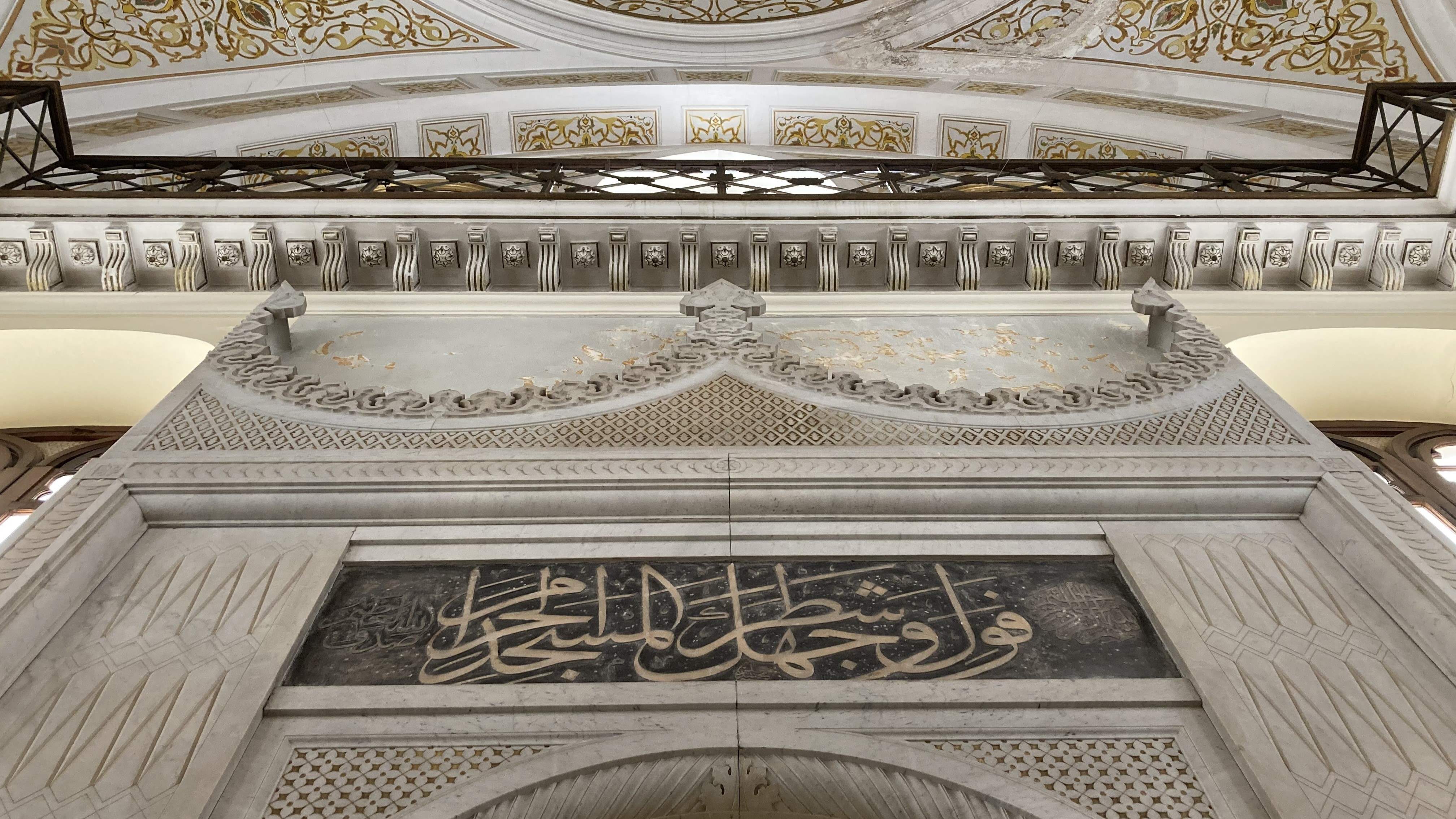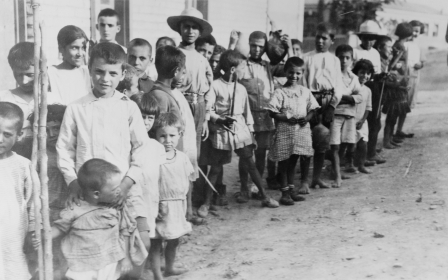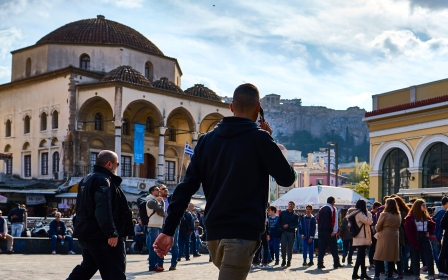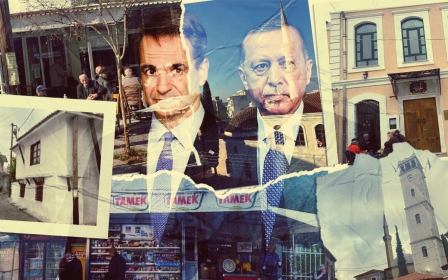Greece: In Thessaloniki, Ottoman monuments are a reminder of a lost cosmopolitan age
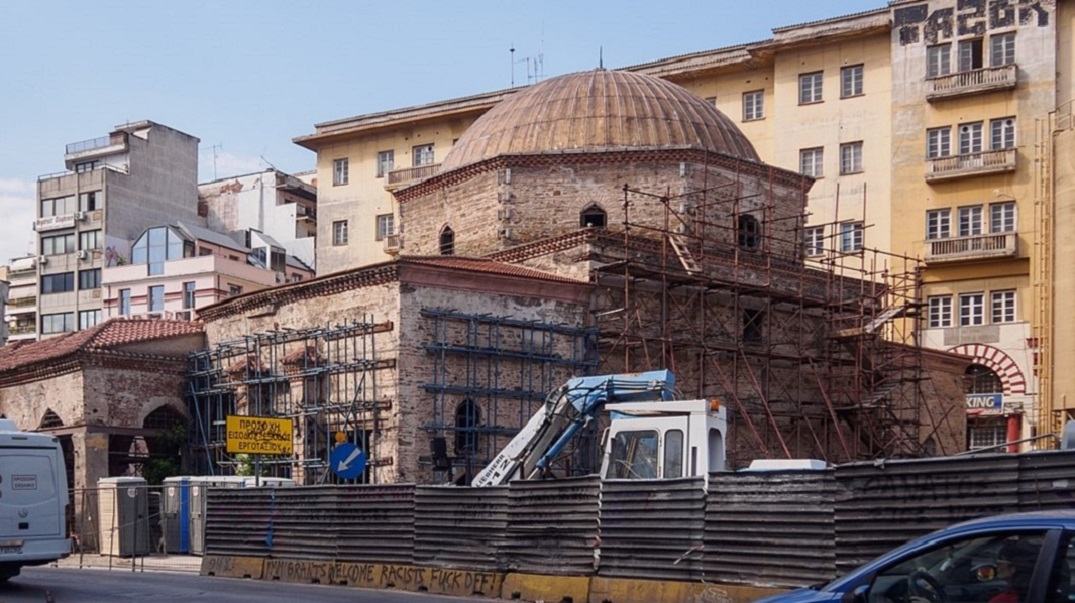
In the upper quarter of Ano Poli in Thessaloniki sits an unassuming fountain that may capture the attention of passers-by.
The fountain is one of the few public monuments in the Greek city showcasing inscriptions in both Arabic and Ottoman Turkish.
Dating back to the early 20th century, the text tells the story of its benefactor, a local mufti called Ibrahim, who had it built in memory of his beloved deceased granddaughter, Namika Hanim.
The meticulously engraved inscription asks all those who drink the fountain's waters to stop and say a prayer for the soul of young Namika.
At the turn of the 20th century, fountains were a common site in Thessaloniki. Such ornate monuments could be found along the winding alleys of Ano Poli, nestled between Ottoman houses characterised by distinctive overhanging balconies and grand wooden doors.
New MEE newsletter: Jerusalem Dispatch
Sign up to get the latest insights and analysis on Israel-Palestine, alongside Turkey Unpacked and other MEE newsletters
Countless minarets from Thessaloniki's many mosques dominated the cityscape, and the call to prayer rang out across the bustling neighbourhoods.
Thessaloniki, which was known as Salonica, during Ottoman times was in many ways a quintessentially Ottoman city, having been integrated into the empire decades before Constantinople.
Its population reflected the diversity of the empire and included Jews, Greeks, Turks, Albanians, Armenians, Bulgarians and many others.
Post-Ottoman Hellenisation
Throughout the 20th century, Thessaloniki bore witness to events that radically transformed its demographic and physical appearance.
Modernisation projects during the Ottoman period set the scene for changes to come, with the demolition of the old Byzantine walls along the waterfront and the construction of a large promenade in its place.
When the city came under Greek rule in 1912, the desire to Hellenise the built environment shaped urban policy and invigorated city planners.
A catastrophic fire in 1917 forced a widescale re-imagining of the city.
The fire ravaged much of the city centre, destroying Jewish neighbourhoods as well as mosques, synagogues and other monuments.
Reconstruction efforts were ambitious, but they largely erased the Jewish and Muslim character of the affected areas.
A few years later, in 1923, Thessaloniki's Muslim population was subject to the disastrous population exchange agreement signed by the Greek and Turkish governments.
The overwhelming majority of the local Muslim population, consisting of Turks, Albanians and other ethnicities, was forced to leave the city on ships heading to the new Turkish republic.
Only a tiny group of Muslims who retained foreign citizenship were allowed to remain in the city.
Signs of Ottoman influence were erased from the public sphere; mosques were shut down and later repurposed for a range of uses; minarets across the city were torn down, Muslim cemeteries were destroyed and many Ottoman-era buildings were redesigned to look more outwardly Hellenic.
Inscriptions in Ottoman were erased from monuments such as the iconic White Tower and Hamidiye Fountain.
Reminders of the city's Muslim community were relegated to obscurity.
Restoring a lost history
The Ottoman structures that have survived remain largely abandoned, with the city's four remaining mosques in varying states of preservation.
The largest and most significant of these is the Hamza Bey Mosque, which has a fascinating history stretching back more than 500 years.
Originally built in the mid-15th century, the mosque is located on a busy junction in the heart of Thessaloniki's commercial district.
For centuries it served as one of the major Muslim houses of worship in the area, surrounded by other Ottoman structures such as a covered bazaar and various hammams, or places for public bathing.
Like many other structures associated with the Ottomans, it was abandoned during the population exchange in 1923 and eventually transformed into a cinema, known locally as the Alkazar.
After the exchange, the cinema became hugely popular among Turkish-speaking Greek refugees who had arrived from Anatolia in the same wave of migration that uprooted Thessaloniki's Muslim community.
The mosque-turned-cinema served as an ideal venue for the screening of Turkish-language films, and was popular with nostalgic Anatolian Greeks.
The cinema was eventually shut down in the 1990s, and access to the mosque has been restricted ever since.
More recently, the construction of a metro station nearby has led to the erection of barriers and scaffolding that obstruct views of the structure.
In May 2023, the Greek Ministry of Culture and Sports announced that the Hamza Bey Mosque would be fully restored and reopened as a museum in 2025, following a multimillion-euro investment project.
The museum will house the various artefacts discovered during the construction of the subway system.
The restoration of the Hamza Bey Mosque represents a milestone in local policy towards the Muslim and Ottoman heritage in Thessaloniki.
Discussions over how and why the city should restore and embrace its Ottoman heritage were virtually non-existent until 2011, when the election of Yiannis Boutaris as mayor of Thessaloniki ushered in new debates about the promotion of the city as a historically cosmopolitan metropolis.
Boutaris, who campaigned on a progressive agenda, consistently advocated for a thorough embrace of Muslim and Ottoman sites in Thessaloniki.
The mayor's brave stance and progressive policies also prompted a backlash from fascists and ultra-nationalists
The mayor argued that the restoration of such sites would benefit the city on many levels, attracting tourists, forging stronger relations with the Muslim world, and promoting Thessaloniki's diverse history.
After coming to power, Boutaris set about pursuing his inclusive agenda, proposing the establishment of an Islamic art museum at the neglected Alaca Imaret Mosque, and allowing local Muslims to perform Eid prayers for the first time in decades at the evocative Yeni Mosque.
A number of factors, including the deeply entrenched economic crisis in Greece and a lack of cooperation at government level, prevented full implementation of the mayor's proposals.
The mayor's brave stance and progressive policies also prompted a backlash from fascists and ultra-nationalists, who assaulted the then 75-year-old Boutaris in 2018.
Nonetheless, the mayor's ambitious and inclusive vision for Thessaloniki will likely continue to inspire future policymakers and cultural heritage activists alike, bringing to light evocative reminders of the city's former Muslim inhabitants.
From the Namika Hanim Fountain to the Hamza Bey Mosque, Ottoman and Muslim sites and monuments across Thessaloniki tell the story of one of the most fascinating chapters in the city's history.
Embracing this history and emphasising the cultural richness of the city would honour Boutaris' vision, increase Thessaloniki's appeal to tourists and serve as a model for other cities and towns across Greece and the Balkans.
This article is available in French on Middle East Eye French edition.
Middle East Eye delivers independent and unrivalled coverage and analysis of the Middle East, North Africa and beyond. To learn more about republishing this content and the associated fees, please fill out this form. More about MEE can be found here.


